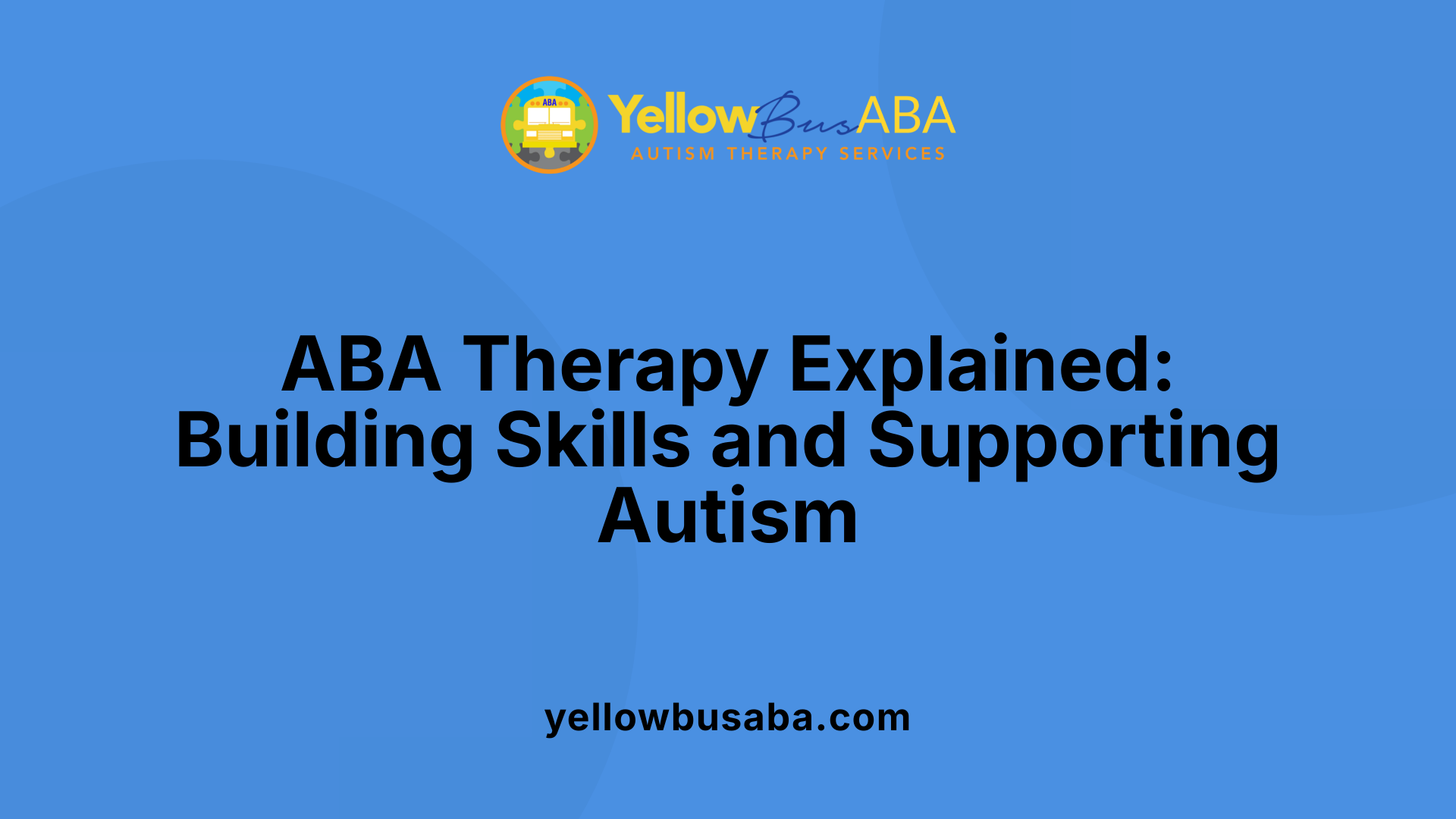Bridging the Gap Between Therapy and Home
Applied Behavior Analysis (ABA) therapy has become a cornerstone in supporting children with autism spectrum disorder (ASD). Increasingly, parents are not only participants in this process but are active learners alongside their children. This collaborative approach enhances the transfer of therapeutic gains beyond clinical settings, fostering a more holistic development for the child and a deeper understanding for the family.
Understanding ABA Therapy and Its Role in Autism Support

What is applied behavior analysis (ABA) therapy and how is it used to support individuals with autism?
Applied Behavior Analysis (ABA) therapy is a scientifically validated approach designed to support individuals with autism spectrum disorder (ASD). It is grounded in the principles of behaviorism, focusing on learning and reinforcement to improve important skills.
ABA therapy targets behaviors such as communication, social interaction, and adaptive functioning. It involves careful assessment of each child's unique needs to develop personalized intervention plans. Certified Behavior Analysts (BCBAs) often oversee these plans to ensure effective implementation.
Therapeutic goals for children with autism
The goals of ABA revolve around enhancing social skills, improving communication abilities, and fostering independence in daily activities. The therapy aims to teach functional behaviors while reducing behaviors that can hinder learning and social participation.
Techniques used in ABA therapy
ABA utilizes various methods to teach new skills and support behavior change, including:
- Discrete Trial Training (DTT): Structured teaching sessions focusing on one skill at a time.
- Natural Environment Training (NET): Learning through real-life interactions and environments.
- Social Skills Training: Encouraging appropriate social behaviors.
Positive reinforcement is a core element, motivating children to acquire and maintain new abilities.
Scientific validation and outcomes
Research consistently supports ABA therapy as an effective intervention for children with autism. Intensive and early implementation of ABA has been linked to significant developmental improvements, including better language use, social engagement, and adaptive behaviors.
Overall, ABA empowers children with autism to enhance their skills and participate more fully in home, school, and community life through individualized, evidence-based practices.
Who Provides ABA Therapy and How Do Families Choose Providers?
Who Typically Provides ABA Therapy Services?
ABA therapy is delivered by a multidisciplinary team of professionals trained in behavior analysis. Key providers include Board Certified Behavior Analysts (BCBAs), Registered Behavior Technicians (RBTs), therapists, and behavioral specialists. These professionals operate within various environments such as specialized clinics, the child's home, schools, and community settings.
Collaboration is a hallmark of effective ABA programs, involving not only the therapy team but also the child's family. This teamwork allows for individualized treatment plans that cater specifically to each child's unique needs. Most service providers are associated with dedicated autism intervention clinics or agencies that emphasize ethical and evidence-based practice standards.
What Qualifications Should One Look for When Choosing an ABA Therapy Provider?
Selecting an ABA therapy provider requires careful consideration of several factors:
- Certification: Ensure the presence of a Board Certified Behavior Analyst (BCBA) or a licensed behavior analyst who designs and oversees treatment protocols.
- Training and Experience: Confirm that therapists and technicians have adequate training, background checks, and relevant experience working with children diagnosed with autism spectrum disorder.
- Licensing Compliance: Verify that the provider holds the necessary licenses and adheres to regulations applicable in your region, such as Missouri licensing requirements.
- Family Collaboration: Choose providers who actively involve families in goal setting and progress monitoring.
- Comprehensive Services: Opt for clinics offering detailed assessments, data-driven treatment adjustment, and programs individualized to the child's behavioral profile.
- Flexibility: Consider service availability across multiple settings (clinic, home, school) and openness to parent involvement in therapeutic activities.
By focusing on these criteria, families can ensure their child receives effective, ethical, and tailored ABA intervention that promotes meaningful behavioral improvements.
Models of ABA Therapy Delivery: Flexibility and Family Engagement
What is Parent-mediated ABA Therapy?
Parent-mediated ABA Therapy (PMT) involves a partnership between parents and professionals. Parents implement ABA strategies at home, guided remotely by Board Certified Behavior Analysts (BCBAs) and Behavior Technicians primarily through telehealth support. This real-time coaching empowers parents with the skills to support their child’s learning effectively, especially benefiting families in remote or underserved areas.
How do At-Home and In-Clinic ABA Therapies Differ?
At-Home ABA Therapy provides one-on-one sessions directly in the child’s home. This setting encourages the generalization of skills into the natural environment and allows parents to observe and learn ABA techniques firsthand. In contrast, In-Clinic ABA Therapy occurs in specialized facilities staffed by trained therapists. It offers a controlled environment equipped with tools and opportunities for social interaction and focused learning.
What Role Does Telehealth Play in ABA?
Telehealth enhances flexibility by enabling professionals to offer remote guidance during Parent-mediated ABA Therapy. This approach bridges geographical gaps, supports bright engagement, and ensures continuity of care. It has proven effective when parents commit to active participation and implementation of ABA techniques.
What Are the Benefits and Challenges of Each Model?
| Therapy Model | Benefits | Challenges |
|---|---|---|
| Parent-mediated ABA Therapy | Empowers parents; flexible scheduling; telehealth access | Requires high parent engagement; potential stress |
| At-Home ABA Therapy | Promotes skill transfer; parental observation | Scheduling conflicts; logistical difficulties |
| In-Clinic ABA Therapy | Access to specialized resources; socialization | Less flexible; travel requirements |
Families should assess their child's unique needs, resource availability, and family capacity when choosing a therapy model. Often, combining different delivery methods optimizes outcomes by balancing structure, flexibility, and engagement.
The Crucial Role of Parents in ABA Therapy

How Does Parental Involvement Benefit ABA Therapy?
Parental involvement in Applied Behaviour Analysis (ABA) therapy is essential for improving outcomes for children with autism spectrum disorder (ASD). Active participation helps extend the skills learned during therapy sessions into the home and community settings, promoting more consistent and meaningful behavior changes.
How Are Parents Trained in ABA Techniques?
Parents can receive direct training on ABA strategies through therapy sessions, equipping them with the tools to reinforce positive behaviors and skills outside of formal therapy. This training often includes learning specific techniques such as discrete trial training and natural environment teaching.
How Does Generalization of Skills Occur at Home?
By practicing ABA principles at home, parents help their children generalize new skills to everyday life. This consistent application ensures that improvements in communication, social interactions, and adaptive behaviors are maintained in real-world environments beyond the clinic.
Why Is Collaboration Between Parents and Therapists Important?
Establishing a collaborative relationship between parents and ABA therapists is critical. Open communication and consistency across therapy and home routines enable the child to receive cohesive support. Working together ensures that therapy goals are aligned and that parents feel confident and supported in their role.
Challenges Faced by Parents and Strategies to Overcome Them

What Emotional, Logistical, and Social Challenges Do Parents Face in ABA Therapy?
Parents involved in ABA therapy often encounter numerous challenges that can affect their ability to support their child effectively. Emotional challenges include stress and burnout due to the intense demands of therapy and managing their child's needs. Logistical obstacles encompass time constraints and transportation issues, which can make attending sessions consistently difficult. Social-relational barriers arise from communication difficulties within the family and societal stigma surrounding autism and therapy participation.
How Do Stress and Burnout Impact Parents?
Stress and burnout are significant risks for parents engaging in ABA therapy. The continuous effort required to implement therapy techniques, manage appointments, and provide emotional support to their child can lead to exhaustion and reduced coping abilities. This emotional toll can affect family dynamics and the overall effectiveness of therapy if not addressed properly.
What Systematic Barriers Exist to Accessing Quality ABA?
Beyond personal and social challenges, parents often face systemic issues such as limited access to qualified therapists and variability in the quality of ABA services. These barriers can delay the start of therapy or reduce the therapy's overall effectiveness, especially for families living in remote areas or with financial constraints.
What Practical Strategies Can Help Families Overcome These Challenges?
Several strategies have proven effective in mitigating these difficulties:
- Scheduling Flexibility: Offering therapy sessions at various times can accommodate busy family schedules and reduce logistical stress.
- Use of Visual Aids: Visual supports can help children and parents better understand and implement therapy strategies.
- Peer and Family Involvement: Encouraging community and family engagement provides emotional support and practical help.
- Engagement with Advocacy Organizations: Connecting with such groups can increase awareness and access to resources.
- Ensuring Access to Qualified Therapists: Pursuing therapy with well-trained professionals ensures adherence to best practices.
By applying these approaches, families can create a more manageable and supportive environment that fosters both the child's progress and the parents’ well-being.
Measuring Progress and Success in ABA Therapy

Data Collection and Behavioral Tracking
Evaluating the success of ABA therapy relies heavily on detailed and systematic data collection. Therapists and parents work together to record specific behaviors, such as the number of words a child speaks or the duration of a social interaction. This data is often presented visually in graphs, assisting in clear tracking of progress over time.
Adjusting Interventions
Regular analysis of collected data allows behavioral analysts to fine-tune interventions. When certain approaches are less effective, adjustments are made to better meet the child's evolving needs, ensuring therapy remains personalized and responsive.
Indicators of Effectiveness
Success isn’t just about numbers; observable improvements are crucial indicators. These include increased social skills, enhanced communication, decreased problematic behaviors, and greater independence in daily living. Improvements in these areas confirm that therapy is yielding positive outcomes.
Parental Feedback and Therapist Collaboration
Parents play an essential role in measuring progress. Their firsthand observations complement clinical data and provide an invaluable perspective on changes in real-life settings. Open communication between parents and therapists fosters a collaborative environment, enhancing the accuracy of evaluations and supporting consistent progress.
| Aspect | Description | Role in Measuring Success |
|---|---|---|
| Data Collection | Systematic tracking of behavior metrics | Provides quantitative evidence of progress |
| Intervention Adjustments | Ongoing modification of therapy strategies | Ensures therapy remains effective and relevant |
| Behavioral Indicators | Observable changes in skills and reductions in challenges | Reflects real-world impact of therapy |
| Parental Feedback | Insights from family observations and experiences | Supplements clinical data for comprehensive evaluation |
| Therapist Collaboration | Continual communication between professionals and parents | Promotes consistent strategies and shared understanding |
Creating a Supportive Home Environment for Sustained Progress
Routines and Consistency
Establishing clear routines and maintaining consistency at home are essential for children undergoing ABA therapy. Predictable daily schedules help the child feel secure and promote smoother learning transitions. Consistency between therapy sessions and home practices ensures that new skills are reinforced effectively.
Positive Reinforcement and Visual Aids
Using positive reinforcement motivates children to repeat desirable behaviors. Parents are encouraged to apply praise, rewards, or preferred activities following successful attempts. Additionally, visual supports such as charts, picture schedules, and cue cards provide clear guidance, helping children understand expectations and tasks.
Balancing Therapy and Unstructured Play
While structured ABA sessions are important, children also need time for unstructured play to express themselves and practice social interactions naturally. Parents should create a healthy balance, allowing their child to enjoy free play, fostering creativity and emotional growth alongside targeted skill development.
Educating Parents on ABA Principles
Understanding ABA's fundamental principles empowers parents to support therapy efforts more confidently. Workshops, online resources, and regular involvement in therapy sessions can increase parents' knowledge and skill in implementing ABA techniques. This education strengthens the home environment as an extension of the therapy setting, promoting sustained progress.
Addressing Criticisms and Ethical Considerations in ABA Therapy

Are there any criticisms or limitations of using ABA therapy for autism?
Applied Behavior Analysis (ABA) therapy has been widely used to help children with autism by teaching useful skills and reducing harmful behaviors. However, it is not without its criticisms and limitations. One main concern is that traditional ABA can be rigid, repetitive, and quite demanding, which may negatively affect a child's emotional well-being.
Historically, some ABA methods used aversive techniques, such as punishment to reduce unwanted behaviors. These practices are now largely discredited and replaced by more positive, play-based approaches, but their past use still influences public perception.
Critics also argue that ABA sometimes emphasizes conformity and compliance, pushing children to suppress natural behaviors that are part of their neurodiversity. This pressure can cause emotional distress and even trauma, as children may feel forced to mask their true selves. There is a risk of losing self-regulatory behaviors if therapy is not carefully individualized or if harsh methods are employed.
Balancing the structured nature of ABA with respect for each child's unique differences is critical. Modern ethical ABA approaches prioritize individualized, positive reinforcement strategies that celebrate neurodiversity and nurture emotional health alongside behavioral improvements.
In summary, while ABA therapy offers significant benefits, it must be applied thoughtfully and flexibly. Incorporating respect for the autistic individual's identity and using supportive, compassionate methods can help avoid potential harms and maximize positive outcomes.
Learning Together: The Foundation for Positive Outcomes
When parents learn alongside their children in ABA therapy, they become empowered advocates and effective facilitators of progress. This collaborative model not only enhances skill development for the child but also supports family resilience and emotional well-being. Despite challenges, informed parental involvement and the choice of qualified professionals, combined with ethical and flexible therapeutic practices, create a nurturing environment where children with autism can thrive. Embracing a partnership approach is essential to transforming therapy into holistic, lifelong growth for both child and parent.
References
- Parental Involvement in Applied Behaviour Analysis (ABA) ...
- Comparing 3 ABA approaches: Parent-mediated, At-home ...
- Supporting a Child in Applied Behavior Analysis (ABA) ...
- ABA Therapy Goals: 25 Practical Examples & Timelines
- Applied Behavior Analysis (ABA)
- Goals of ABA Therapy: Fostering Growth & Celebrating ...
- How to Measure ABA Therapy's Effectiveness
- ASD Intervention Effectiveness: How Do We Measure ...
- Applied Behavior Analysis (ABA)



.jpg)

.avif)
